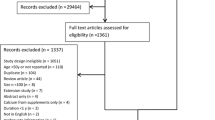Abstract
Objective: The hypothesis was tested that the rate of postmenopausal bone loss is inversely associated with long-term urinary excretion of phyto-oestrogens, as a marker of habitual dietary intake.
Design: Secondary analysis of a 10-year follow-up study (1979–1989) among postmenopausal women in the Netherlands.
Subjects: From the original population of 154 women, 32 women were selected with an annual rate of radial bone loss of ≤0.5% over the first 5 years of the study and 35 women with a rate of ≥2.5% per year.
Methods: The isoflavonoids genistein, daidzein and equol, and the lignan enterolactone were determined by gas chromatography–mass spectrometry in aggregate samples from annually collected urine samples. Cortical bone density of the radius had previously been measured annually by single-photon absorptiometry.
Results: Excretion of isoflavonoids did not differ between both groups, although in multivariate analysis equol excretion was weakly positively associated with rate of bone loss in the 5 years after the menopause. Enterolactone excretion was significantly higher in the group with high rate of bone loss. This positive association remained in multivariate linear regression analysis after adjustment for age, years since menopause, body mass index and intake of calcium, vegetable protein and dietary fibre.
Conclusions: Enterolactone excretion is likely to be an indicator of consumption of grains and legumes; it is not clear whether the observed positive association with rate of bone loss is a causal one. Our results do not support a preventive effect of low, unsupplemented dietary intake of phyto-oestrogens on postmenopausal cortical bone loss. However, no conclusions can be drawn about effects of higher doses of phyto-oestrogens.
Sponsorship: This study was supported by the Dutch Prevention Fund, a charity organisation.
This is a preview of subscription content, access via your institution
Access options
Subscribe to this journal
Receive 12 print issues and online access
$259.00 per year
only $21.58 per issue
Buy this article
- Purchase on Springer Link
- Instant access to full article PDF
Prices may be subject to local taxes which are calculated during checkout
Similar content being viewed by others
Author information
Authors and Affiliations
Rights and permissions
About this article
Cite this article
Kardinaal, A., Morton, M., Brüggemann-Rotgans, I. et al. Phyto-oestrogen excretion and rate of bone loss in postmenopausal women. Eur J Clin Nutr 52, 850–855 (1998). https://doi.org/10.1038/sj.ejcn.1600659
Received:
Revised:
Accepted:
Published:
Issue Date:
DOI: https://doi.org/10.1038/sj.ejcn.1600659
Keywords
This article is cited by
-
A new norlupane triterpene from the leaves of Acanthopanax koreanum increases the differentiation of osteoblastic MC3T3-e1 cells
Archives of Pharmacal Research (2010)
-
Urinary phytoestrogen concentrations in the U.S. population (1999–2000)
Journal of Exposure Science & Environmental Epidemiology (2005)


